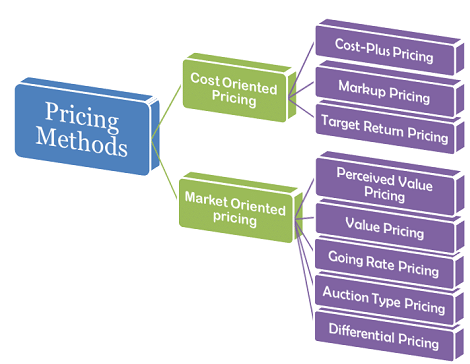Pricing Methods | Cost Accounting - B Com PDF Download
Definition: The Pricing Methods are the ways in which the price of goods and services can be calculated by considering all the factors such as the product/service, competition, target audience, product’s life cycle, firm’s vision of expansion, etc. influencing the pricing strategy as a whole.
The pricing methods can be broadly classified into two parts:
- Cost Oriented Pricing Method
- Market Oriented Pricing Method

Cost-Oriented Pricing Method: Many firms consider the Cost of Production as a base for calculating the price of the finished goods. Cost-oriented pricing method covers the following ways of pricing:
- Cost-Plus Pricing: It is one of the simplest pricing method wherein the manufacturer calculates the cost of production incurred and add a certain percentage of markup to it to realize the selling price. The markup is the percentage of profit calculated on total cost i.e. fixed and variable cost.
E.g. If the Cost of Production of product-A is Rs 500 with a markup of 25% on total cost, the selling price will be calculated asSelling Price= cost of production + Cost of Production x Markup Percentage/100
Selling Price=500+500 x 0.25= 625
Thus, a firm earns a profit of Rs 125 (Profit=Selling price- Cost price) - Markup pricing- This pricing method is the variation of cost plus pricing wherein the percentage of markup is calculated on the selling price.E.g. If the unit cost of a chocolate is Rs 16 and producer wants to earn the markup of 20% on sales then mark up price will be:
Markup Price= Unit Cost/ 1-desired return on sales
Markup Price= 16/1-0.20 = 20
Thus, the producer will charge Rs 20 for one chocolate and will earn a profit of Rs 4 per unit. - Target-Return pricing– In this kind of pricing method the firm set the price to yield a required Rate of Return on Investment (ROI) from the sale of goods and services.E.g. If soap manufacturer invested Rs 1,00,000 in the business and expects 20% ROI i.e. Rs 20,000, the target return price is given by:
Target return price= Unit Cost + (Desired Return x capital invested)/ unit salesTarget Return Price=16 + (0.20 x 100000)/5000Target Return Price= Rs 20
Thus, Manufacturer will earn 20% ROI provided that unit cost and sale unit is accurate. In case the sales do not reach 50,000 units then the manufacturer should prepare the break-even chart wherein different ROI’s can be calculated at different sales unit.
Market-Oriented Pricing Method: Under this method price is calculated on the basis of market conditions. Following are the methods under this group:
- Perceived-Value Pricing: In this pricing method, the manufacturer decides the price on the basis of customer’s perception of the goods and services taking into consideration all the elements such as advertising, promotional tools, additional benefits, product quality, the channel of distribution, etc. that influence the customer’s perception.
E.g. Customer buy Sony products despite less price products available in the market, this is because Sony company follows the perceived pricing policy wherein the customer is willing to pay extra for better quality and durability of the product. - Value Pricing: Under this pricing method companies design the low priced products and maintain the high-quality offering. Here the prices are not kept low, but the product is re-engineered to reduce the cost of production and maintain the quality simultaneously.
E.g. Tata Nano is the best example of value pricing, despite several Tata cars, the company designed a car with necessary features at a low price and lived up to its quality. - Going-Rate Pricing- In this pricing method, the firms consider the competitor’s price as a base in determining the price of its own offerings. Generally, the prices are more or less same as that of the competitor and the price war gets over among the firms.
E.g. In Oligopolistic Industry such as steel, paper, fertilizer, etc. the price charged is same. - Auction Type pricing: This type of pricing method is growing popular with the more usage of internet. Several online sites such as eBay, Quikr, OLX, etc. provides a platform to customers where they buy or sell the commodities. There are three types of auctions:
1. English Auctions-There is one seller and many buyers. The seller puts the item on sites such as Yahoo and bidders raise the price until the top best price is reached.
2. Dutch Auctions– There may be one seller and many buyers or one buyer and many sellers. In the first case, the top best price is announced and then slowly it comes down that suit the bidder whereas in the second kind buyer announces the product he wants to buy then potential sellers competes by offering the lowest price.
3. Sealed-Bid Auctions: This kind of method is very common in the case of Government or industrial purchases, wherein tenders are floated in the market, and potential suppliers submit their bids in a closed envelope, not disclosing the bid to anyone. - Differential Pricing: This pricing method is adopted when different prices have to be charged from the different group of customers. The prices can also vary with respect to time, area, and product form.
E.g. The best example of differential pricing is Mineral Water.The price of Mineral Water varies in hotels, railway stations, retail stores.
Thus, the companies can adopt either of these pricing methods depending on the type of a product it is offering and the ultimate objective for which the pricing is being done.
|
104 videos|132 docs|14 tests
|
FAQs on Pricing Methods - Cost Accounting - B Com
| 1. What are the different pricing methods used in business? |  |
| 2. How does cost-plus pricing work? |  |
| 3. What is value-based pricing? |  |
| 4. How does penetration pricing work? |  |
| 5. What is skimming pricing? |  |
















